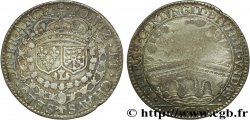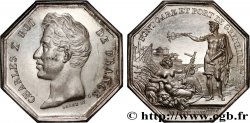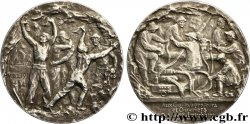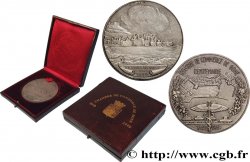fjt_254168 - PONTS ET CHAUSSÉES / BRIDGES AND ROADS PERCEMENT DU PREMIER TUNNEL DU LOETSCHBERG OU LÖTSCHBERG 1911
240.00 €(Approx. 280.80$ | 208.80£)
Quantity
Add to your cart

Type : PERCEMENT DU PREMIER TUNNEL DU LOETSCHBERG OU LÖTSCHBERG
Date: 1911
Metal : silver
Diameter : 36 mm
Orientation dies : 12 h.
Edge : lisse
Puncheon : losange ARGENT
Rarity : R2
Coments on the condition:
Remarquable travail de gravure, très novateur pour l’époque
Obverse
Obverse legend : NOVBRE 1906 / AVRIL 1911 .
Obverse description : Quatre mineurs se congratulant au percement final du tunnel signé René Grégoire 1911.
Reverse
Reverse legend : AUX COLLABORATEUR ET OUVRIERS DU TUNNEL DU LŒTSCHBERG , LONGUEUR 14536 M.
Reverse description : Sept ouvriers manipulant une foreuse hydraulique allant à gauche.
Commentary
Ce tunnel qui relie en Suisse les cantons de Berne et du Valais est présenté à http://fr.wikipedia.org/wiki/Tunnel_du_L%C3%B6tschberg mais il a récemment été doublé par un nouveau tunnel du même nom, mais de 34,6 kilomètres de long, voir http://fr.wikipedia.org/wiki/Tunnel_de_base_du_L%C3%B6tschberg.
This tunnel, which connects the cantons of Bern and Valais in Switzerland, is presented at http://fr.wikipedia.org/wiki/Tunnel_du_L%C3%B6tschberg but it has recently been doubled by a new tunnel of the same name, but 34.6 kilometers long, see http://fr.wikipedia.org/wiki/Tunnel_de_base_du_L%C3%B6tschberg
This tunnel, which connects the cantons of Bern and Valais in Switzerland, is presented at http://fr.wikipedia.org/wiki/Tunnel_du_L%C3%B6tschberg but it has recently been doubled by a new tunnel of the same name, but 34.6 kilometers long, see http://fr.wikipedia.org/wiki/Tunnel_de_base_du_L%C3%B6tschberg








 Report a mistake
Report a mistake Print the page
Print the page Share my selection
Share my selection Ask a question
Ask a question Consign / sell
Consign / sell
 Full data
Full data















